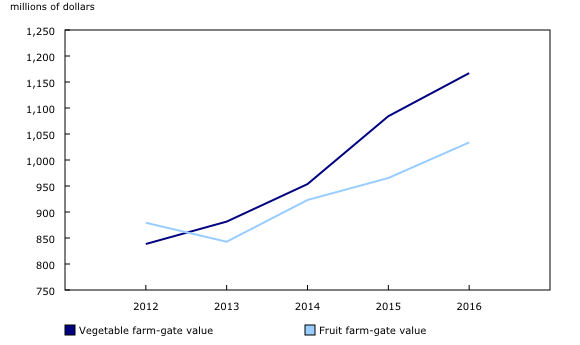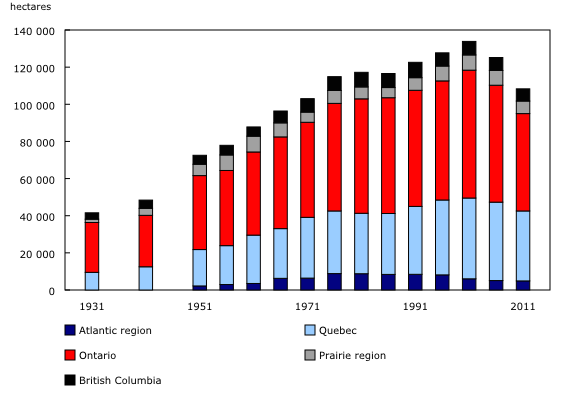Fruit and vegetable production, 2016
Archived Content
Information identified as archived is provided for reference, research or recordkeeping purposes. It is not subject to the Government of Canada Web Standards and has not been altered or updated since it was archived. Please "contact us" to request a format other than those available.
Released: 2017-02-01
The farm-gate value of Canadian fruit and vegetable products rose 7.4% from 2015 to $2.2 billion in 2016. Favourable weather conditions resulted in increased production, which contributed mainly to this growth.
Total fruit and vegetable cultivated area rose 2.3% to 235 976 hectares in 2016. Area dedicated to fruit cultivation amounted to 131 406 hectares, while vegetable area totalled 104 570 hectares. Ontario, Quebec and British Columbia accounted for 90.1% of total vegetable cultivated area and 65.3% of total fruit cultivated area.
After passing the $1-billion mark in 2015, the value of vegetables continued to grow in 2016, up 7.6% to $1.2 billion. Carrots, tomatoes, lettuce, dry onions, sweet corn, broccoli and peppers accounted for more than 50% of the total value of field-grown vegetables in Canada.
Carrot sales amounted to $122.9 million in 2016, followed by tomatoes ($111.6 million), lettuce ($88.1 million), dry onions ($87.1 million) and sweet corn ($75.6 million).
Total production of tomatoes rose 15.1% to 489 003 tonnes, while their value rose 26.5% to $111.6 million. Warm weather conditions in Southern Ontario during June, July and August were beneficial for tomato production. In 2016, the Ontario tomato yield was 1.7 tonnes per hectare above the five-year average. To absorb this higher production, Ontario producers had new market opportunities in 2016.
The total value of fruits rose 7.1% to exceed the $1-billion mark for the first time in 2016.
Low bush (wild) and high bush blueberries accounted for one-quarter of total national fruit value in 2016. However, oversupply in North American markets affected prices for both types of blueberries. For wild blueblerries, producers received 69 cents per kilogram on average from processors in 2016 compared with $1.18 a year earlier.
High bush blueberry production rose 6.4% to 85 769 tonnes, but the value decreased by 0.1% to $170.8 million. British Columbia production represented 95.6% of total high bush blueberry production in Canada.
Wild blueberry production was up 41.2% to 132 235 tonnes. Quebec production recovered from a 2015 decline with a 141.1% increase to 54 475 tonnes in 2016. In New Brunswick, production rose 11.7% to 37 216 tonnes. However, with low prices, wild blueberry value declined 17.9% to $90.7 million in 2016.
In 2016, apple sales represented about one-fifth of the total national fruit value. The overall apple yield in Canada increased 13.9%, mainly because Ontario recovered from a 15.8% production decrease in 2015, which was due to winter damage and a late spring frost. Ontario represented 38.8% of total apple production volumes in 2016, followed by British Columbia (25.8%), Quebec (25.6%) and Nova Scotia (8.5%).
Total grape value increased 24.5% to $151.1 million. Favourable weather conditions contributed to higher yields in different wine-producing regions of Canada. Ontario (57.2%) accounted for the largest share of the total grape value, followed by British Columbia (37.7%).
The value of cranberries rose 8.2% to $135.3 million and volume was up 8.5% to 158 817 tonnes in 2016. Quebec (65.2%) and British Columbia (28.9%) accounted for the largest shares of the total volume.
Lower values were reported for peaches (-9.2%) and sweet cherries (-3.6%), while higher values were reported for small fruits such as strawberries (+7.1%) and raspberries (+9.7%).
The evolution of vegetable production in Canada
As 2017 marks the 150th anniversary of Confederation, we take a look back at historic vegetable production in Canada. The total vegetable area increased from 41 564 hectares in 1931 to 108 321 hectares in 2011.
Vegetables are now produced on larger scale farms. The average size of farms reporting vegetables has increased from 2.1 hectares per farm in 1951 to 12 hectares per farm in 2011. Updates on area and number of farms reporting vegetables will be available with the release of the 2016 Census of Agriculture on May 10, 2017.
Note to readers
Farm-gate value is the value received by producers at the point of first transaction, when ownership first changes hands. This value excludes any separately billed costs such as delivery, storage, marketing and administrative.
Contact information
For more information, contact us (toll-free 1-800-263-1136; 514-283-8300; STATCAN.infostats-infostats.STATCAN@canada.ca).
To enquire about the concepts, methods or data quality of this release, contact Rita Athwal (613-863-7249; rita.athwal@canada.ca), Agriculture Division.
- Date modified:




